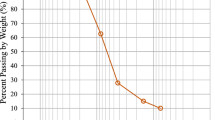Abstract
Landslide monitoring and warning using inertial measurement units (IMUs) has shown the potential for remote and real-time applications. However, the studies conducted using the IMU sensors are limited to rainfall-induced landslide detection using soil moisture sensors and accelerometers for predicting slide and measuring tilt, respectively. The tilting of the slope might not occur during a slow-moving translational slide, and it may not always be possible to accurately record the soil moisture condition. The use of raw acceleration data, which is the combination of linear and gravitational accelerations, for calculating tilt or motion is another drawback of the existing studies. Hence, there is a need for a better approach to monitor slides. This paper presents two methods to define movement thresholds and criteria to identify the translational soil slides based on our understanding of the sensor data recorded during the two laboratory experiments. BNO055 sensor devices (IMU sensors) with 3-axis accelerometers and 3-axis gyroscopes were selected for this study. The linear accelerations, gravitational accelerations, and angular velocities were utilized to understand the translational soil slides by correlating the sensor behavior to that of the slope. The interpretation of the movements during the failure at each sensor location was further verified by referring to the videos recorded by two pi-cameras. The outcomes of this study confirm the applicability of the proposed IMU sensor system and the movement thresholds for effective and reliable monitoring and warning of translational soil slides.






Similar content being viewed by others
References
Azzam R, Arnhardt C, Fernandez-Steeger TM (2010) Monitoring and early warning of slope instabilities and deformations by sensor fusion in self-organized wireless ad-hoc sensor networks. In: Proceedings of the international symposium and the 2nd AUN/seed-net regional conference on geo-disaster mitigation in ASEAN-protecting life from geo-disaster and environmental hazards 2526
Bosch Sensortec (2014) Data sheet - BNO055 intelligent 9-axis absolute orientation sensor. https://cdn-shop.adafruit.com/datasheets/BST_BNO055_DS000_12.pdf. Accessed 8 May 2016
Casagli N, Catani F, Del Ventisette C, Luzi G (2010) Monitoring, prediction, and early warning using ground-based radar interferometry. Landslides 7(3):291–301. https://doi.org/10.1007/s10346-010-0215-y
Casagli N, Cigna F, Bianchini S, Hölbling D, Füreder P, Righini G, Del Conte S, Friedl B, Schneiderbauer S, Iasio C, Vlcko J (2016) Landslide mapping and monitoring by using radar and optical remote sensing: examples from the EC-FP7 project SAFER. RSASE 4:92–108. https://doi.org/10.1016/j.rsase.2016.07.001
Dehls J, Giudici D, Mariotti F, Farina P, Martin D, Froese CR (2010) Monitoring turtle mountain using ground-based synthetic aperture radar (GB-InSAR). In Proceedings of the 64th Canadian Geotechnical Conference. Calgary, Alberta, p 1635–1640
Eberhardt E (2013) Extensometers. In: Bobrowsky PT (ed) Encyclopedia of natural hazards, Encyclopedia of Earth sciences series. Springer, Dordrecht
Fernandez R (2010) Calculate everything from Iphone’s accelerometer and magnetometer sensors. http://rouel-projects.blogspot.com/p/calculations-with-iphones.html. Accessed 16 July 2016
Giri P (2018) Landslide monitoring and warning using wireless sensor network system. Dissertation, University of Wyoming
Giri P, Ng K, Robinson C, Phillips W, Phillips M (2016) Understanding the behavior of rock-fall motion using wireless sensor technology. In Geo-Chicago: 584–595. https://doi.org/10.1061/9780784480120.059
Kanungo DP, Maletha AK, Singh M, Sharma N (2017) Ground based wireless instrumentation and real time monitoring of Pakhi landslide, Garhwal Himalayas, Uttarakhand (India). In: Workshop on World Landslide Forum: 293–300. Springer, Cham. https://doi.org/10.1007/978-3-319-53487-9_33
Kim HW (2016) Development of wireless sensor node for landslide detection. In Proceedings of APAN 42:56–60
Lee HC, Ke KH, Fang YM, Lee BJ, Chan TC (2017) Open-source wireless sensor system for long-term monitoring of slope movement. IEEE Trans Instrum Meas 66(4):767–776. https://doi.org/10.1109/TIM.2017.2657838
Neto P, Pires JN, and Moreira AP (2013) 3-D position estimation from inertial sensing: minimizing the error from the process of double integration of accelerations. arXiv preprint arXiv:1311.4572
Ooi GL, Wang YH, Tan PS, So CF, Leung ML, Li X, Lok KH (2014) An instrumented flume to characterize the initiation features of flow landslides. Geotech Test J 37(5):748–768. https://doi.org/10.1520/GTJ20130158
Ramesh MV (2014) Design, development, and deployment of a wireless sensor network for detection of landslides. Ad Hoc Netw 13:2–18. https://doi.org/10.1016/j.adhoc.2012.09.002
Reeves B, Noon DA, Stickley GF, Longstaff D (2001) Slope stability radar for monitoring mine walls. In: Subsurface and surface sensing technologies and applications III 4491: 57–68. International Society for Optics and Photo-Dermatology Photonics. https://doi.org/10.1117/12.450188
Simeoni L, Mongiovì L (2007) Inclinometer monitoring of the Castelrotto landslide in Italy. J Geotech Geoenviron 133(6):653–666. https://doi.org/10.1061/(ASCE)1090-0241(2007)133:6(653
Smarsly K, Georgieva K, König M (2014) An internet-enabled wireless multi-sensor system for continuous monitoring of landslide processes. Ad Hoc Netw 6(6):520–529. https://doi.org/10.7763/IJET.2014.V6.752
Stark TD, Choi H (2008) Slope inclinometers for landslides. Landslides 5(3):339–350. https://doi.org/10.1007/s10346-008-0126-3
Starlino Electronics (2009) A guide to using IMU (accelerometer and gyroscope devices) in embedded applications. http://www.starlino.com/imu_guide.html. Accessed 8 Nov 2017
Tohari A, Nishigaki M, Komatsu M (2007) Laboratory rainfall-induced slope failure with moisture content measurement. J Geotech Geoenviron 133(5):575–587. https://doi.org/10.1061/(ASCE)1090-0241(2007)133:5(575
Tran DT, Nguyen DC, Tran DN, Ta DT (2015) Development of a rainfall-triggered landslide system using wireless accelerometer network. IJACT 7(5):14
Varnes DJ (1978) Slope movement types and processes. Special Report 176:11–33
Wang KL, Hsieh YM, Liu CN, Chen JR, Wu CM, Lin SY, Pan HY (2015) Using motion sensor for landslide monitoring and hazard mitigation. In: Intelligent environmental sensing. Springer, Cham, pp 111–127. https://doi.org/10.1007/978-3-319-12892-4_5
Acknowledgements
The authors would like to express their gratitude to the University of Wyoming Tier I Engineering Initiative for funding this research study. Special thanks is given to Intelligent Wireless Sensor Network (IWSN), Inc. for their collaboration with the UW research team in designing and developing the wireless sensor network system for hazard monitoring and warning. The authors are grateful to Marian Phillips from Silent Solutions Security, LLC for helping in the management of the laboratory and field studies.
Author information
Authors and Affiliations
Corresponding author
Rights and permissions
About this article
Cite this article
Giri, P., Ng, K. & Phillips, W. Laboratory simulation to understand translational soil slides and establish movement criteria using wireless IMU sensors. Landslides 15, 2437–2447 (2018). https://doi.org/10.1007/s10346-018-1055-4
Received:
Accepted:
Published:
Issue Date:
DOI: https://doi.org/10.1007/s10346-018-1055-4




